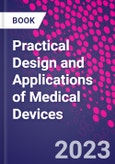Practical Design and Applications of Medical Devices focuses on devices which receive and transmit bioelectric signals, such as electrocardiograph, electrodes, blood flow, blood pressure, physiological effects and, in some cases, current flowing through the human body. This thorough guide for researchers and engineers in the field of biomedical and instrumentation engineering presents a streamlined medical strategy for designing these medical devices, sensors, and tools. It also promotes operational efficiency in the healthcare industry, with the goals of improving patient safety, lowering overall healthcare costs, broadening access to healthcare services, and improving accessibility.
Please Note: This is an On Demand product, delivery may take up to 11 working days after payment has been received.
Table of Contents
1. Design of Interactive Neural Input Device for Arm Prosthesis2. Internet of Things-Based Patient Well-being Monitoring System
3. IoT-Based Infant Monitoring Device
4. Construction of a miniaturized COVID-19 medical kit
5. Development of a polymerase chain reaction device
6. Construction of an electrophysiotherapy device
7. Voice Control Prosthetic Hand
8. 3D Bioprinting of Prosthetic Leg
9. Face Recognition System to diagnose a disease using Computer Web Camera
10. Detection of Retinal Blood Clots of Eye Using Laser Doppler Technology
11. Sleep Apnea Detection Device
12. Design considerations for the Diagnostic Radiology Department
13. Construction of an automated hand sanitizer dispenser used against transmissible diseases
14. Design and Modeling of a Novel Blood Sampling (phlebotomy) Chair
15. A speech recognition system using technologies of audio signal processing and characteristics extraction
16. Blood Circuit in Hemodialysis
17. Design of Endoscopic Medical Devices
18. Temperature Reducer Machine
19. Development of a brain-computer interface (BCI) device that converts brain signals to audio and written words
20. A Dual Biventricular Resynchronized Pacemaker with a Remote Monitoring System
21. The design of a non-invasive blood pressure measurement device
22. Electromechanic Hand Driven by EMG Signal
Authors
Dilber Uzun Ozsahin University of Sharjah, United Arab Emirates.Dr. Dilber Uzun Ozsahin is an accomplished Associate Professor in the Medical Diagnostic Imaging Department of the College of Health Science at the University of Sharjah. She serves as the director of the Operational Research Centre in Healthcare at the Near East University since 2020 and is establishing a new research group focused on operational research and integrated artificial intelligence in healthcare at the University of Sharjah.
Ilker Ozsahin Near East University, USA.Assoc. Prof. Ilker Ozsahin is a highly experienced professional in the field of medical imaging, specializing in technologies such as Positron Emission Tomography, Positron Emission Mammography, Single Photon Emission Computed Tomography, and Compton Camera. With a diverse scientific background encompassing high-energy physics, solid-state physics, and medical imaging, he has conducted research across various prestigious institutions worldwide. Ilker's academic pursuits have taken him to the University of Illinois in the USA, where he studied carbon nanotube formation, and to Universidad Autonoma de Barcelona in Spain, where he completed his PhD studies on PET. Additionally, he served as a research assistant at Cukurova University in Turkey for six years while pursuing his PhD. Following the completion of his doctoral degree, he was awarded the International Postdoctoral Research Scholarship by The Scientific and Technological Research Council of Turkey, enabling him to conduct postdoctoral research at Harvard Medical School (HMS) and Massachusetts General Hospital (MGH). During this time, he contributed to the development of advanced gamma cameras and image reconstruction algorithms, as well as investigating the impact of general anesthesia on brain function in small animals using functional imaging techniques. Ilker has also worked as a visiting postdoctoral fellow at the University of Macau, focusing on multi-pinhole SPECT collimator design for brain, cardiac, and small animal imaging. Additionally, he has conducted research at CERN for HCAL upgrade studies in the CMS experiment. Currently, Ilker serves as an Associate Professor in the Biomedical Engineering Department at Near East University and holds the position of visiting fellow at Cornell University.








